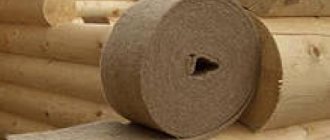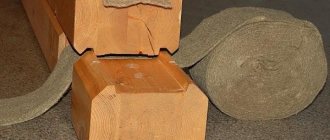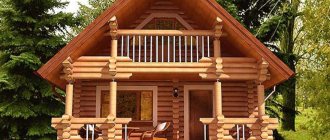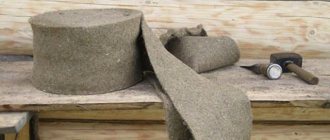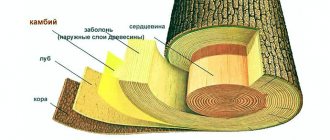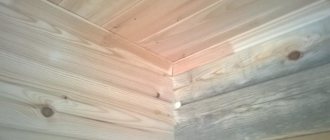In the modern world, more and more attention is being paid to the environmental side. This manifests itself in almost all areas of human activity, including construction. Today the fashion for wooden houses is returning. Structures made of logs or laminated veneer lumber can increasingly be found not only in rural areas, but also in urban areas.
But such construction requires compliance with its own certain rules. For example, no matter what material you build a wooden house from, it is imperative to insulate the inter-crown space. Only in this case can you get perfectly comfortable housing, plus reliably protect the building from external influences. Which inter-crown insulation is better to choose?
Natural materials
When building wooden houses, our ancestors used natural materials - tow and moss - as insulation. Today, not everyone will caulk a house like that. This kind of work is quite hard and requires certain skills. But modern builders often use inter-crown insulation made from natural materials.
First of all, it’s worth talking about flax wool. Already from the name itself you can understand what material it is made from.
Linen wool is made from natural raw materials, therefore it is safe for human health
Linen has been used for a long time, including for insulating inter-crown spaces. This material has its advantages, namely:
- This insulation is made not from industrial waste, but from natural raw materials. That is why such inter-crown insulation for timber or logs will help create a special microclimate that is favorable for humans in the room;
- the material is produced in strips, which allows for insulation along the entire length and width of the crown;
- linen provides an excellent moisture balance. When there is an excess of it in the room, the material begins to absorb water, and when there is a shortage, it gives it back. In addition, such insulation is breathable, which means your walls will “breathe.”
Linen wadding is made using a non-woven method, it is pressed to the desired density. The result is stripes ranging from 1 to 20 centimeters wide. The length of such a tape can reach two meters. These sizes make it easy to choose the option necessary for your case.
Linen batting is placed between logs or beams. If the thickness is not enough, the strips can be mounted in two layers, securing them with staples. When laying it, it is important that the insulation does not extend beyond the edges of the crown.
Jute insulation is installed using a construction stapler
When answering the question – which inter-crown insulation for timber should you choose, you cannot ignore jute material. This option is very popular.
Jute insulation is made from a tropical plant, which is a long vine. After special processing and drying, the resulting insulation is lightweight and easy to install.
Jute contains lignin. This resin is a natural antiseptic, which helps protect jute insulation from the harmful effects of moisture. In addition, the presence of lignin in jute helps prevent rotting of the timber or log itself.
Jute interventional insulation retains its thermal insulation properties for a long time
But this advantage can also become a disadvantage. The fact is that a large amount of lignin in the material leads to gluing of the fibers to each other. As a result, jute insulation loses its elasticity and its thermal insulation qualities. To get rid of this drawback, manufacturers produce a mixed version.
Flax is added to pure jute inter-crown insulation. The combination of fibers may be different, depending on the manufacturer’s technology. As a rule, there are two main options:
- flax jute. In this case, most often, the ratio of raw material fibers is one to one. Jute makes up the outer layers, and flax is placed inside. It turns out to be a kind of multi-layer “pie”. This insulation has the elasticity of flax, and the strength and rigidity of jute;
- jute felt. This insulation for the crown joints of a wooden house is made of ten percent flax and ninety percent jute. In jute felt, the fibers of the raw materials are not placed in layers, but mixed. As a result, flax prevents jute from sticking together and gives the material the necessary elasticity.
The insulation is produced in strips of various widths and lengths. Jute inter-crown insulation is installed in the same way as when using flax wool.
As an inter-crown insulation for timber or logs, you can choose a material made from sheep wool - felt. This option is gradually gaining popularity.
Sheep wool insulation (felt) allows you to insulate your home better
Previously, felt was used as inter-crown insulation only in countries with developed sheep breeding. But recently, this steel material has been produced on an industrial scale and supplied all over the world.
Natural felt fibers do not cake and do not lose their elasticity. This feature allows the insulation to maintain its thermal insulation properties for a long time. In addition, felt is able to fill everything, even the smallest cracks and depressions, which means your home will be insulated with high quality. The disadvantage of the material is its high price.
Popular manufacturers and prices
On sale inter-crown insulation made from natural plant fibers are represented by the following brands: “Thermo-Hanf”, “Val-Flax”, “ThermoLen” (“ThermoJUT”), “Flaxan”, “Ekoteplin”, “Ecoterm”, “Ekolen”, etc. ., both Russian-made and European manufacturers. More detailed information about them is given in the work: “Review of flax insulation.”
Let us separately note the prices. So, for 1 linear m with a thickness of 5 mm, a width of 15 cm and a density of 450 g/m2 must be laid out for products from:
- flax - 11 rubles;
- jute - 13 rubles;
- jute mixed with flax - 12 rubles.
With changes in thickness and width, as well as density, prices also change.
Synthetic insulation is produced by:
- "Holofiber" - enterprise "Thermopol" (Moscow);
- "Polytherm" is a center for inter-crown insulation (Moscow).
For comparison, we present the price per 1 linear meter. the same parameters as natural fibers - 32.7-43.6 rubles.
"Ancient" methods of insulation
You can also use simpler and long-used options. For example, use moss as insulation. Many species of this plant grow in nature, but only two varieties are best suited for insulating a wooden house:
- sphagnum - has a large amount of antiseptic substances. This feature allows you to reliably protect your home from the harmful effects of the environment;
- Kukushkin flax has less antiseptic effect. This moss is not laid completely dry, so its thermal insulation properties will be better.
Such insulation will help create a better microclimate in your home. This is created due to the aroma of the forest that the material emits. There will always be a pleasant atmosphere in your home.
Ordinary moss - sphagnum - can be used as inter-crown insulation.
The moss itself is environmentally friendly and does not cause allergies. But assembling it yourself is quite difficult. Moss grows in swamps and other damp places. In addition, each variety requires its own technology for collection and preparation for use. It is quite difficult to prepare it in the required quantities yourself, so this method of insulating the inter-crown space is rarely used today.
For your home, you can choose a simple tow. This material is made from various raw materials, it can be flax or hemp. But such insulation has one “bad” property: birds really like it. The fibers are easily separated from the main mass, which forces the seams to be repaired annually. In addition, tow absorbs moisture well and can rot.
Final Recommendation
By the way, recently (on the eve of the New Year) a fellow colleague of mine bought flax-jute fabric at. He liked the conversation with the consultant (in his words, he understands issues of wooden house construction very well) and the price of the product was quite reasonable. This is not an advertisement - just a consultation, which is always useful. I recommend this company for residents of Moscow and the Moscow region. Moreover, the company is specialized and has been on the construction market for several years.
Well, perhaps he said everything he wanted. If it was informative, then do not miss the release of new information. Do you have friends who are building a bathhouse or a house? Recommend the article to them.
Good luck and warm, well-caulked walls. Bye!
Quote of wisdom: This is how men are made: they can resist the smartest arguments and cannot resist a single glance (Bazzak).
Artificial materials
When answering the question - how to choose inter-crown insulation for timber, you cannot ignore artificial materials. Today this option is the most popular. One of these materials is called “holofiber”.
This insulation is made from polyester fibers using the non-woven method. The material is produced in rolls and plates, each type has its own density.
Holofiber has high elasticity. This feature is very convenient for thermal insulation of crown joints, especially when using laminated veneer lumber or non-profiled timber.
This material has no pores, which means it can warp when drying. If insulation made from natural material is used, then the appearance of cracks is inevitable. When using holofiber, additional sealing of the crown joints after the timber has dried is not required. The fibers of this material will fill the cracks that appear on their own.
Holofiber does not absorb water and retains its thermal insulation properties
In addition to a high degree of elasticity, holofiber has a number of other advantages. Experts include the following among the most significant of them:
- has low water absorption rates, less than one percent. This means that holofiber will not absorb moisture and will retain its thermal insulation properties longer even in a humid climate;
- the material does not burn even at high temperatures. This property is very important for thermal insulation of wooden buildings;
- Insects “don’t like” the material; they definitely won’t live here. In addition, holofiber is not afraid of mold;
- not only has high thermal insulation properties, but is also an excellent sound insulator;
- Holofiber has a long service life, and even over time does not require additional caulking.
You should not think that holofiber can have a detrimental effect on human health. This material does not cause allergies, does not emit harmful substances and is absolutely environmentally friendly. There can only be one drawback. If wood that was too damp was used during construction, it may be prohibited. Holofiber does not allow the walls of the house to “breathe”.
Another common inter-crown insulation for wooden houses made of profiled or laminated timber is “shelter”. This material is made from polyester fiber. Just like holofiber, it has high elasticity, which allows you to fill all the cracks newly formed as a result of shrinkage of the house. Shelter does not rot, does not absorb moisture and retains heat perfectly.
There are also more modern materials, for example, “polytherm”. At its core, it is a type of holofiber, but with greater elasticity. According to the manufacturers, the material can last 50 years. But polytherm appeared not so long ago, only about ten years ago, so it is not possible to test this in practice.
Inter-crown insulation “Polytherm” can last up to 50 years
An alternative to interventional insulation
Sometimes sealants are used instead of standard insulation. The decision is ambiguous. On the one hand, it’s quick and simple, on the other, it’s expensive and there’s a high risk of mold and mildew in the area of the gaps (the sealant doesn’t allow steam to pass through).
Alternatively, sealant can be used to create beautiful seams inside the house.
Seal the gap with sealant.
In conclusion, properly insulating the gaps between the crowns creates a comfortable living environment in the house. The work is not difficult - the whole process can be done with your own hands.
Let's sum it up
What material to choose is up to the owner of the house to decide. Each option has its pros and cons. Natural inter-crown insulation, especially combined flax and jute, has the best environmental friendliness.
But, as a rule, such material has a relatively short service life (about 10-20 years), after which you will have to caulk the seams.
Artificial material will last longer, according to manufacturers, up to 50 years or more. However, do not be afraid of its unnatural origin. Modern insulation materials undergo many tests before entering the market. Therefore, they will not cause harm to human health.
From a short video you will learn how to properly install inter-crown insulation.
Refinement of a bathhouse made of timber: inter-crown insulation and walls from the inside
It must be remembered that an erected wooden bathhouse is capable of shrinking during the first 1.5-2 years.
In the process of building a bathhouse, it is very important to take care not only of a strong and reliable structure, but also of a high-quality insulating layer, despite the material from which the bathhouse is built. Thermal insulation protects the bath room from heat loss. The steam room is characterized by a rather humid and hot environment, since the temperature in it can reach 90 degrees and the humidity over 70 percent. Such an atmosphere is not at all easy to maintain, because even with an extremely powerful stove, the temperature in the steam room will drop without proper insulation.
Let us summarize the disadvantages of the lack of thermal insulation in the bathhouse:
- Overconsumption of energy and material resources, since heating will require much more materials;
- The load on the furnace will increase, which will lead to rapid wear of the equipment;
- The steam room will heat up very slowly and lose heat very quickly;
- High temperatures and moisture have a very negative effect on the structure of the building, so in just a few years repairs will be needed.
What is the best gasket for logs in a log house? Expert opinion
A variety of building materials are used to build houses, bricks, concrete panels, cinder blocks, but the highest quality and most durable material is wood. Houses built from wood are warm, durable and very beautiful. Such houses can be built from either timber or logs, but it is the second version of the material that is being used more and more often, due to its most optimal cost and at the same time its excellent characteristics. In the construction of a log house, the main thing is its insulation and the correct choice of insulation material, of which there are many.
Jute
Another natural inter-crown insulation, consisting of fibers from a plant of the linden family. Natural jute is becoming increasingly widespread due to the following advantages:
• Environmental friendliness of natural material.
• Good thermal insulation characteristics.
• Simple installation of material made in the form of a tape.
• Laying speed. Jute tape does not require caulking.
• Contains a large amount of lignin - a natural antiseptic, prolongs the life of wood, slows down biological decomposition.
• High strength and durability.
• The color and composition of the insulation is similar to wood.
Among the disadvantages, it can be noted that jute is rarely used for chopped baths due to its high cost.
Necessity
This material performs several important functions at once:
- Reliably isolates the space between the crowns of the house, inaccessible for inspection, from water and moisture, which, over time, can seriously damage the house;
- Does not allow air to blow through the cracks between the logs;
- Compensates for changes in wood volume that occur due to seasonality and changes in temperature and humidity.
The timber is insulated both at the construction stage and after, the so-called caulking of the log house.
As a conclusion: the inter-crown seal serves not only as a heat insulator, but also:
- Performs waterproofing functions;
- Increases the service life of the building.
The choice of such material must be approached very carefully.
Performance characteristics
High-quality insulation, which is laid between the crowns of logs or beams, must meet high standards of quality and safety of use. Therefore, the main performance characteristics of the material include:
- High elasticity and density, maintaining properties throughout the entire period of operation. Thanks to its elasticity, the insulation is able to take the desired shape, and its density is able to fill existing gaps between the crowns.
- Low thermal conductivity for effective protection of walls from heat loss.
- High moisture and vapor permeability.
- Resistance to mold, fungi and harmful microorganisms that arise when exposed to increased moisture and heat.
- Resistant to ultraviolet exposure and adverse weather conditions.
Other
Of course, the three examples we have given are not a complete list of insulation between logs. For these purposes use:
- Sheep wool;
- Jute;
- Polytherm.
We will talk about all these materials in separate publications. For example, many people are interested in what is better to use, flax or jute, for inter-crown space.
And someone asks: what is better, jute or moss?
We will devote a separate article to jute insulation in the near future.
This article deliberately did not discuss all the issues related to seals
However, we have collected the most important and useful. Which inter-crown insulation for timber to choose for your home depends on various factors and the main ones are the financial component and efficiency
The chosen option must correspond to the overall design of the building.
Advantages of jute
Safety
The insulation must be safe for human health. In the bath we enjoy the smell of natural wood and get healthier, so the materials used should not contain any harmful components.
Fire resistance
The insulation for a bath should not flare up from every little spark. Experts recommend using materials no higher than the second flammability group.
Biological resistance
The insulation should not attract the interest of birds and allow the emergence and proliferation of various fungi and bacteria.
Vapor permeability
In a steam room, humidity and temperature constantly fluctuate, and condensation of water in the inter-crown space can only be avoided by using materials with a good ability to transmit moisture without rotting the wood
Therefore, pay attention to the coefficient of vapor and air permeability of the material
Country bathhouse
Durability
Good insulation lasts as long as the structure itself, and at the same time maintains its integrity and elasticity throughout the entire period of use.
What to choose
Since ancient times, natural and durable material – wood – has been used to build a real Russian bathhouse.
However, many years of experience show that it is impossible to achieve an ideal joint of materials either in manual cutting or in production, and this entails heat loss directly through the walls.
In this regard, even at the first stages of construction, each of the rows is laid with inter-crown insulation.
This allows you to completely eliminate heat loss through cracks in the walls.
Today, the most popular materials used as inter-crown insulation for baths are:
- Linen;
- Moss;
- Jute;
- Other insulation materials.
Let's look at each of the categories in more detail. Important! All internal components of the wood structure must be dry and properly treated with antiseptics
Felt (sheep's wool)
A natural material for insulation, which in its performance properties is superior to tape insulation made from plant fibers.
Felt is a worthy option for buildings made of profiled timber. It is simply irreplaceable for insulating residential buildings and baths, although it is not cheap.
During the production process, the felt seal is carefully treated with special fire-retardant compounds, as a result of which it absorbs moisture well and quickly releases it when heated.
It is resistant to mold and mildew and does not cake during use.
Other
Of course, the three examples we have given are not a complete list of insulation between logs. For these purposes use:
- Sheep wool;
- Jute;
- Polytherm.
We will talk about all these materials in separate publications. For example, many people are interested in what is better to use, flax or jute, for inter-crown space.
And someone asks: what is better, jute or moss?
We will devote a separate article to jute insulation in the near future.
Do-it-yourself finishing caulk
After the log house has been subjected to shrinkage, finishing caulking is carried out at home. During the shrinkage process, the previously laid layer of insulation is deformed, voids can form in the inter-crown cracks, and vertical cracks can form in the corners of the frame. The operation is performed from the outside and inside. Caulking is a labor-intensive process that requires diligence and attention; the main tool is a wide wooden chisel or rubber mallet. To avoid damaging the integrity of the fibers, it is better to blunt the chisel. The operation begins with the lower crown along the entire perimeter, after caulking of the first crown is completed, they move on to the second, etc.
We insulate the bathhouse from the outside
Insulating does not only mean protecting from blowing. Insulate - ensure conditions for maintaining a stable thermal regime indoors.
For log cabins or when building bathhouses in areas with mild winters, it is quite enough to carry out external insulation of the walls to protect the bathhouse from heat leaks. Inside there is only finishing made from natural materials.
At the same time, it is possible to insulate the walls from the outside immediately after the shrinkage of the log house, based on the thickness of its elements and the density of the crowns.
The attic is subject to external insulation:
- the ceiling is covered with glass hydrosol;
- it is filled with expanded clay, slag, or mineral mats are laid over the insulator;
- a reinforced or non-reinforced screed is made on top.
For external wall insulation, ventilated facade technology is used:
- a sheathing frame is created along the width of the sheets (mats, slabs) of insulation, exceeding the thickness of the sheets by 3 cm (for the ventilation gap);
- the insulation is laid in the sheathing structure from bottom to top:
- the diffuse membrane is attached to the sheathing with a stapler;
- Facades are faced with varnished lumber, false beams or colored siding.
Necessity
The joint of logs is the weakest point of a log structure. Firstly, this is where the wall thickness is smallest, and secondly, initially it is an open gap into which moisture and wind can penetrate. To protect this “deprived” area of a wooden house, insulation for logs is used.
This material performs several important functions at once:
- Reliably isolates the space between the crowns of the house, inaccessible for inspection, from water and moisture, which, over time, can seriously damage the house;
- Does not allow air to blow through the cracks between the logs;
- Compensates for changes in wood volume that occur due to seasonality and changes in temperature and humidity.
The timber is insulated both at the construction stage and after, the so-called caulking of the log house.
As a conclusion: the inter-crown seal serves not only as a heat insulator, but also:
- Performs waterproofing functions;
- Increases the service life of the building.
The choice of such material must be approached very carefully.
Linen seal
Another natural material that has long been used to insulate houses is flax tow. Tow is obtained by carding dried flax. This is a fibrous material resembling cotton wool with large fibers of plant origin.
When assembling a log house, the roll is rolled out on top of the log and shot with a construction stapler:
This will reduce the time and effort spent on subsequent caulking of the log house. Rolled material made from flax has all the advantages and disadvantages of tow. The advantages of flax wool include:
- the material breathes well, allowing you to maintain the heat and humidity balance in the room;
- the material is able to maintain its heat and sound insulation properties for a long time;
- compacts well and is quite elastic;
- has hypoallergenic properties.
The disadvantages of flax wool include:
- predisposition to debate, rotting of fibers;
- is a “delicacy” for insects and, without special treatment, quickly becomes a cozy “home” for a wide variety of woodworms;
- birds steal material for nest construction.


